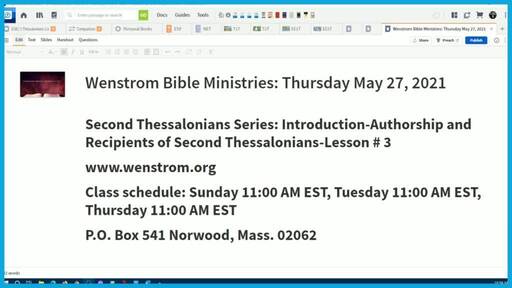Second Thessalonians-Introduction Part 3
Doctrinal Bible Church
Pastor-Teacher Bill Wenstrom
Sunday March 2, 2025
Second Thessalonians Series: Introduction Part 3
Lesson # 3
The city of Thessalonica belonged to the Roman province of Macedonia, which lay on the Balkan peninsula north of Greece, south of Illyria and Thrace, and East of Epirus.
Its territory included Haliacmon and Axius rivers and their tributaries, which flow southeast to the Thermaic Gulf of the Aegean Sea.
Most of the country is mountainous, cut by great river valleys, and remote from the sea.
Unlike peninsular Greece, its climate is much more eastern European than Mediterranean, with summer and winter rains, severe winters, and very hot summers.
This makes it suitable for most horses, cattle, sheep, cereals, and European fruits, but not for olives or figs.
It is very important that we understand the background of the city of Thessalonica in order to understand this city’s inhabitants.
As we noted, it was located in Macedonia and was the largest and most important city in the Roman province of Macedonia, which was divided in four regions with Thessalonica was the capital city of this region.
It was also located along the Via Egnatia and as a port city on the Aegean Sea, which thus made it strategic for trade.
During the first century A.D., Thessalonica was inhabited by Greeks, Romans, Jews and a Christian population which was growing (Acts 17:4-5).
Thessalonica rapidly became populous and wealthy.
The city of Thessalonica served as the junction of major land and sea trade routes which included Via Egnatia, which was one of the Roman Empire’s major east-west highways.
The city still remains an important port in Greece.
Acts 17 and 18 present evidence which indicates that Paul wrote First Thessalonians from the city of Corinth between 49-52 A.D. and sometime after planting the church in Thessalonica.
This is indicated by the fact that Paul mentions Timothy rejoining him at Corinth from Thessalonica (1 Thess. 3:1-2, 6; cf. Acts 17:13-15; 18:1, 5).
While in Corinth, Paul appeared before the proconsul Gallio (Acts 18:1-7) whose reign as proconsul was between 51-52 or 52-53.
Corinth was an influential Graeco-Roman city in the Peloponnesus where Paul spent 18 months on his second missionary journey.
The church at Corinth was the recipient of two canonical Pauline works, namely First and Second Corinthians.
Corinth was about 48 miles west of Athens and was founded by Dorian Greeks in the tenth century B.C. and had established colonies at Corfu and Syracuse (Sicily) by the eighth century B.C. Corinth was destroyed by the Romans in 146 B.C.
It was rebuilt about a century afterwards and was populated by a colony of freedmen from Rome.
In 44 B.C. Julius Caesar undertook to refound the city name it Colonia Laus Julia Corinthiensis.
Thus, it was a fairly new city in the days of Paul.
It was the third-largest city of the Roman Empire.
As we noted in our study of First Thessalonians, this epistle was written in approximately 49 A.D. shortly after Paul’s arrival in Corinth (Acts 17:1-10; 18:1).
This indicated is indicated by comparing Acts 18:1-17 with ancient secular inscriptions.
The former mentions Paul in Corinth meeting a man named Gallio who was said to be the proconsul of Achaia.
The latter mentions this man’s proconsulate in Corinth.
Most conservative scholars date First Thessalonians between 50-54 A.D. which would make this epistle one of the earliest of Paul’s inspired writings.
Now, if one accepts the accuracy of the Acts account, it appears therefore that Second Thessalonians must have been written during Paul’s stay in Corinth because he, Silvanus and Timothy were together after that according to the accounts in the New Testament.
The contents of Second Thessalonians reveal that the conditions in Thessalonica are the same as described in the contents of First Thessalonians.
Therefore, this would indicate that Second Thessalonians was sent within a year of First Thessalonians or more than likely, the former was sent even within months of the latter.
Like First Thessalonians, there are five major themes found in Second Thessalonians.
They share four of these, however, unlike First Thessalonians, the rapture of the church is not a major theme in Second Thessalonians.
The first major theme in Second Thessalonians is thanksgiving (cf. 1:3-4; 2:13-14) and the second is persecution (cf. 1:4-10) and the third is the concern that the Thessalonians would continue to exercise their post-justification faith in the gospel (1:3-4, 11-12; 2:13-16).
The fourth is the eschatological day of the Lord (2:1-12) and the fifth and final major theme in Second Thessalonians is church discipline (3:6-14).





